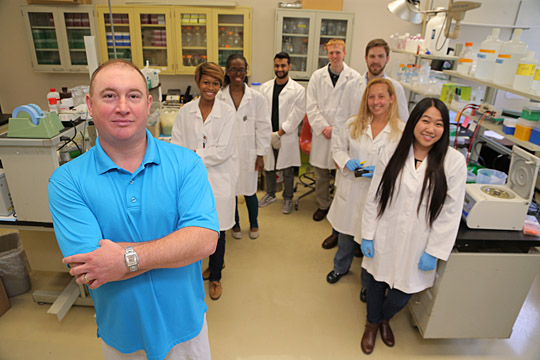Researchers at The University of Toledo have designed a new drug that has shown promise in the treatment of Type 2 diabetes, obesity and cardiovascular disease.
Dr. Terry Hinds Jr., assistant professor in the UT Department of Physiology and Pharmacology, constructed new molecules that could lead to the development of medications that not only lower blood glucose levels for Type 2 diabetics, but also may help to manage a patient’s weight and blood pressure.

Dr. Terry Hinds Jr., left, is assisted in the lab by, from left, Assumpta Nwaneri, Imani Driskell, Vikram Sundararaghavan, Kevin Stephenoff, Lucien McBeth, Kari Neifer-Sadhwani and Justina Tain.
Bilirubin is an orange-yellow pigment formed naturally in the liver by the breakdown of hemoglobin.
The new molecules are created from a half bilirubin structure that binds directly to a receptor that lowers blood glucose and body fat percentage. Hinds and his research team termed the new compounds Thin Molecules. He worked in collaboration with Dr. Paul Erhardt and Dr. Chris Trabbic at UT’s Center for Drug Design and Development and Dr. David Stec from the University of Mississippi Medical Center.
“For a long time, we thought bilirubin was harmful to the body,” Hinds said. “In the past decade, research has shown that bilirubin is a powerful antioxidant that was inversely associated with obesity and waist circumstance.”
Hinds discovered that bilirubin has a function outside of its role as an antioxidant by also binding to the fat-burning nuclear receptor PPARalpha, which helps to more effectively metabolize fat and reduce obesity levels.
Slightly increased levels of bilirubin in the body can mean positive results for Type 2 diabetics.
“We think the Thin Molecules will be especially effective at reducing obesity and blood glucose, as well as lowering blood pressure,” Hinds said.
This discovery was published in April in the Public of Library Science journal PLOS ONE, and a provisional patent has been approved for the Thin Molecules.
Hinds and his research team now are building a library of the molecules to continue testing to determine which provide the most benefit.